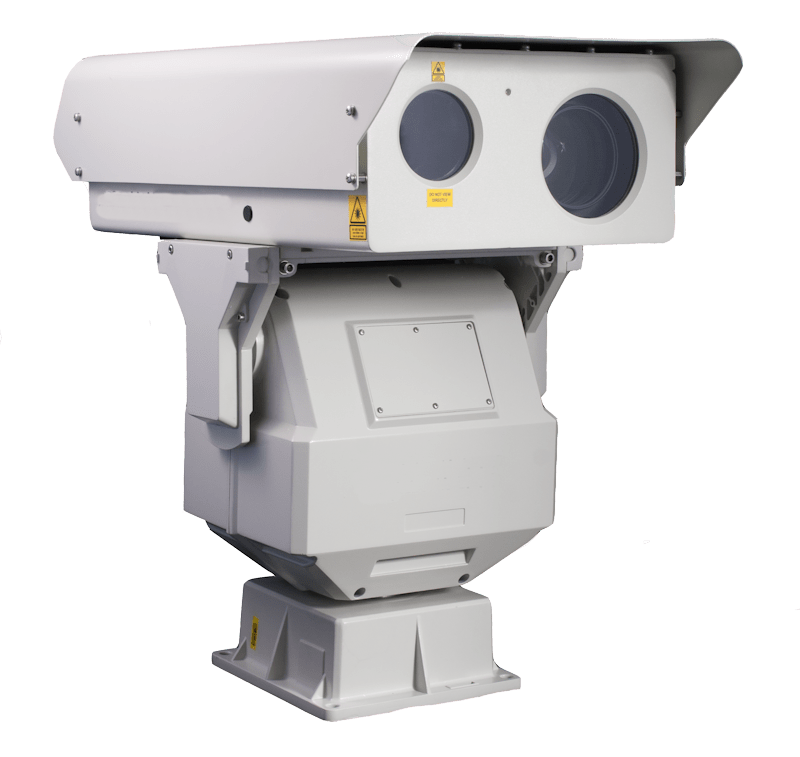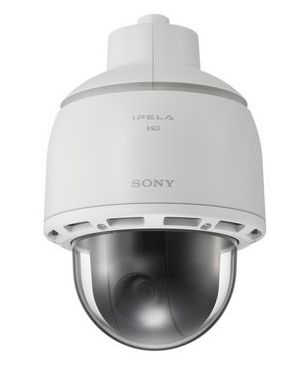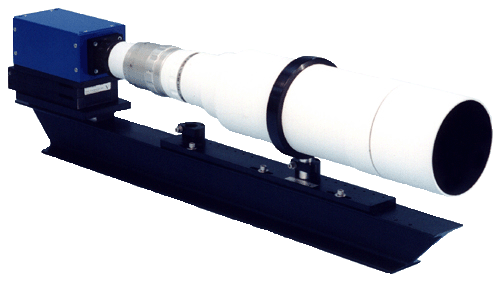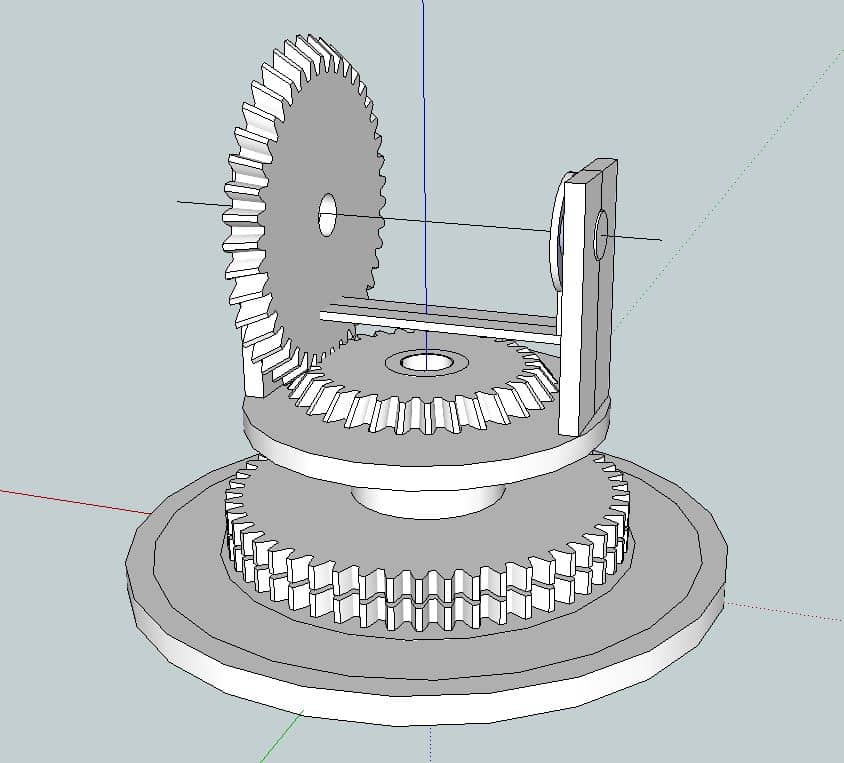
Do you want to be able to read a license plate over a mile away? You can do it with the latest very long range PTZ IP camera systems. There are long range camera systems that are best for daytime operation and others that can be used day or night.
Be careful about low priced systems that claim long range capability. They don’t have the high quality zoom lenses or laser illuminators that are used in professional camera systems.
In our previous article How Far Can We See with the PTZ IP Camera, we reviewed the difference between detecting a person or vehicle, recognizing the type of object, or identifying who the person is. Each criteria requires a different amount of resolution on the target.
This article reviews the components that make up a long range camera system, and shows how total system performance determines the price.
The Long Range IP Camera System

The least expensive PTZ camera systems are all-in-one cameras with zoom lenses, pan, tilt control and sometimes IR illuminators, built into one dome housing. During the daytime these cameras provide detection ranges of up to 3200 m (1.9 miles).
For example, the Sony PTZ camera has 30X zoom, and the Samsung IP camera has 32X zoom. Both are excellent cameras for daytime applications. There are also dome PTZ cameras with built in IR illuminators. For example the Samsung 32X PTZ model includes an IR illuminator with a range of 150 m (492 ft.).
As the range increases, separate specialized components are required. These systems are custom made for the specific application. They have a range of over 10 miles. These very long distance IP camera systems include a high performance, high resolution camera with special long range zoom lens; a very precise pan, tilt mechanism, optical illuminators, and possibly an additional thermal camera. Each part of the system plays an important part in assuring the right level of performance. Everything must work together to assure that you get what you expect.
Cameras that only operate during the day, are much simpler than ones that also see in the dark. The performance of daytime cameras are determined by the zoom lens, and pan-tilt mechanism. Cameras that can operate at night are much more complicated (and expensive). In this application a special high powered laser illuminator is added, or we add a thermal imaging camera that operates in total darkness. These complex systems include thermal cameras for detecting objects and then optical cameras with a laser illuminator for zooming in to see the details.
The Optical Camera
The IP cameras used in the longest range camera systems have very high performance sensors that provides at least 2 Megapixel resolution, as well as good low light performance. The camera systems accept a variety of different zoom lenses, have auto-focus, and possibly connections for the pan, and tilt control. These special cameras use 1/2.8 inch, or 1/1.8 inch sensors. The larger sensors usually provide better low light performance (0.002 lux in color) versus the smaller sensor (0.02 lux in color).
The Thermal Camera
The thermal camera operates in total darkness. Instead of using reflected light from the sun or IR laser, it detects the heat differences from all the objects in the field of view. It has less resolution than the optical camera. Most of our systems use 640 x 480 resolution cameras, but there are 320 x 240 resolution cameras available as well, which cost less. These cameras provide gray-scale (BW) video so it provides less image detail than we can get from an optical camera.
Special germanium lenses are used that allow thermal radiation to pass through them. Regular CCTV lenses reflect the thermal energy so cannot be used for this application. There are fixed lenses and special zoom lenses available for thermal cameras, but their range is much less than the optical lenses available.
Lens for Optical Camera

The long range zoom lens systems are one of the most expensive parts of the system. The lens not only has to provide excellent zoom capability, it must also be able to allow the most light through it. It should also focus correctly with standard or IR lighting (IR corrected). We measure the performance of the lens by the line pairs per millimeter of resolution, the lens aperture or f-stop, minimum horizontal angle at full zoom, auto-iris, motorized focus and zoom.
The longer the range of lens, the more the lens weighs. This increases the requirements for the Pan-Tilt mechanism, and consequently increases the cost.
Pan-Tilt Mechanism

The pan-tilt mechanism controls the horizontal and vertical direction of the camera system. The performance is measured by the speed of motion and accuracy. The further away you want to view an area, the more precision you need.
There are different types of pan-tilt drive mechanisms with some using belts and others using gears. The gears are more precise.
The pan-tilt mechanism may also include position sensors that make sure the mechanism reaches the exact location required. With the right control system it can be positioned to 0.01 degrees of accuracy.
When the camera system is used in mobile applications, the mechanism must be very rugged, allowing it to survive mechanical vibration and shock.
The speed of motion required depends on what you want to see. If you plan to track a ship at sea, or maybe a truck moving down a road, you may be able to use a system that moves about 12 degrees per second. Tracking faster moving objects is much more difficult, and you may need a state-of-the-art high speed, and higher cost mechanism. The maximum speed of the pan-tilt mechanism depends on the weight of the total camera system. For example, the Samsung PTZ dome camera with IR illuminator pans at up to 120 degrees/sec. while the heavier multi-sensor long distance cameras can only pan at about 20 degrees/sec.
Laser Illuminator
The laser illuminator provides focused IR light up to 5 Km away. The effective range is determined by the camera low light sensitivity and lens low light capability (maximum f-stop). Cameras with larger sensors provide better low light sensitivity, which maximizes the nighttime range of the camera system. The better quality laser illuminators adjust the focus angle so that it maximizes the light depending on the focal distance of the optical zoom lens. This reduces hot spots that can affect the video quality.
Laser illuminators must be used with care. Lasers with over 15 Watt power levels can exceed the danger limit for human eyes at close range. This is called the Nominal Ocular Hazard Distance (NOHD). The risk of eye damage can be reduced by preventing people from being too close to the illuminator. For example a person should not be closer than 185 m when a 15 W laser is used. An active range finder system can be added to the camera system that automatically turns off the illuminator whenever an object is closer than this minimum range. Usually we recommend safety measures with lasers that use over 15 Watts of power.
Cost-Performance Comparison of Long Range Camera Systems
The following chart provides examples of IP camera systems that are available. Remember that we custom design cameras for your exact requirements, and the chart is just providing some examples. It will give you some idea of how much it costs for a certain level of performance. The camera systems are designed and assembled with specific lenses, thermal cameras, laser illumination and pan-tilt mechanisms.
As you may imagine, the longer the range the less detail you can see. At the farthest range, you can just detect that something is there, but you can’t really determine what it is. For example, at the maximum range, the model SNP-6322RH-WM, provides enough zoom and resolution to be able to detect a human at a distance of 3.8 miles. As the target gets closer, you can just about recognize that it is a human and not a vehicle. At the closest range you can start to identify if the human is a man or a woman. For example, the camera can identify a human at a range of 0.5 miles. You would have to be a lot closer to be able to identify who the person is. If the object was a vehicle, then you could detect it at over twice the distance away, depending on the size of the vehicle.
The chart provides the range for detecting to identifying a human target. At some point between the detection range and identification range, you can recognize that it is a human, rather than a vehicle.
The pricing is provided just to give you some idea of what to expect. It is estimated based on system performance and may be different depending on specific features required. For example, you may require special mounting, video management software, and video recording system.
| MODEL | Description | Range | Estimated Pricing |
|---|---|---|---|
| SNP-6322RH-WM | PTZ Dome camera with 32X zoom lens and maximum zoom of 140 mm | Daytime only: 3.8 to 0.5 miles (6.2 Km to 0.82 Km) | $2,900 – $3,500 |
| TVIP-LR33-500 | PTZ System with 33 X lens and maximum zoom of 500 mm | Daytime only: 11 miles to 1.5 miles (18 Km to 2.5 Km) | $24,000 – $28,000 |
| TVIP-PHX-640-30X-50HD | Multi-sensor camera system with 37X zoom lens with up to 129 mm of zoom and, 640×480 thermal camera with 100 mm lens | Daytime: 3.7 miles to 0.49 miles (5.9 Km to 0.7 Km.)
Night: 0.72 miles to 0.09 miles (1.1 Km to 0.153 Km) | $22,000 – $26,000 |
| TVIP-SGMA-1000M-500mm | Very long range day-night camera with laser illuminator | Daytime: 14 miles to 1.8 miles (22 Km to 3 Km.)
Night: 0.62 miles (1 Km with laser)
| $32,500 – $35,000 |
| TVIP-OPTH-5000M-1500-HD | Extreme range multi-sensor camera with laser illuminator. Includes up to 1500 mm zoom lens, thermal cameras with 35 – 155 mm zoom thermal lens, and 5000 m range laser. | Daytime: 32 miles to 4.27 miles (51 Km to 6.8 Km.)
Night: Thermal Camera: 0.96 miles to 0.13 miles (1.5 Km to 0.2 Km). Laser Illuminator: 3 miles (5 Km) | $130,000 – $150,000 |
Summary
Long range camera systems can be used to see objects many miles away. These cameras include a number of components. As you can see from the chart above, as the range and performance increase, the price goes up.
If you need help designing your long range IP camera system, just give us a call. We have many years of experience with these systems, so we can help assure that you get the exact system you need, at the right price. We can be reached at 1-800-431-1658 in the USA, and 914-944-3425, everywhere else. You can also use our contact form.